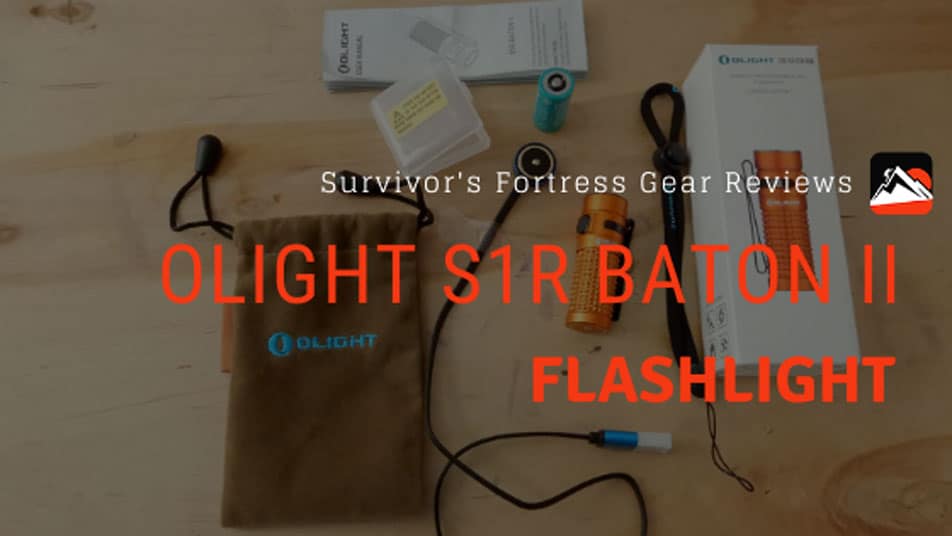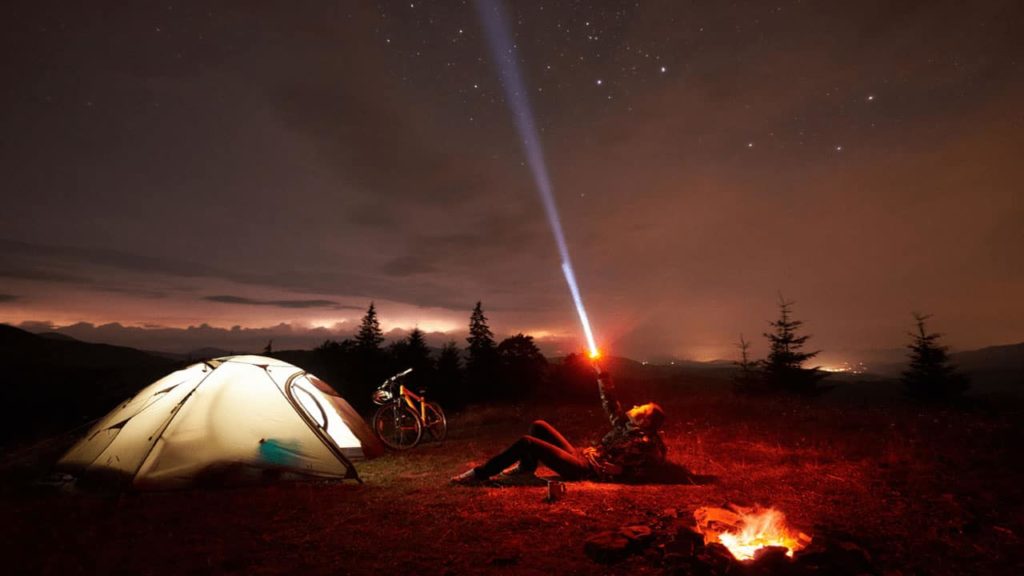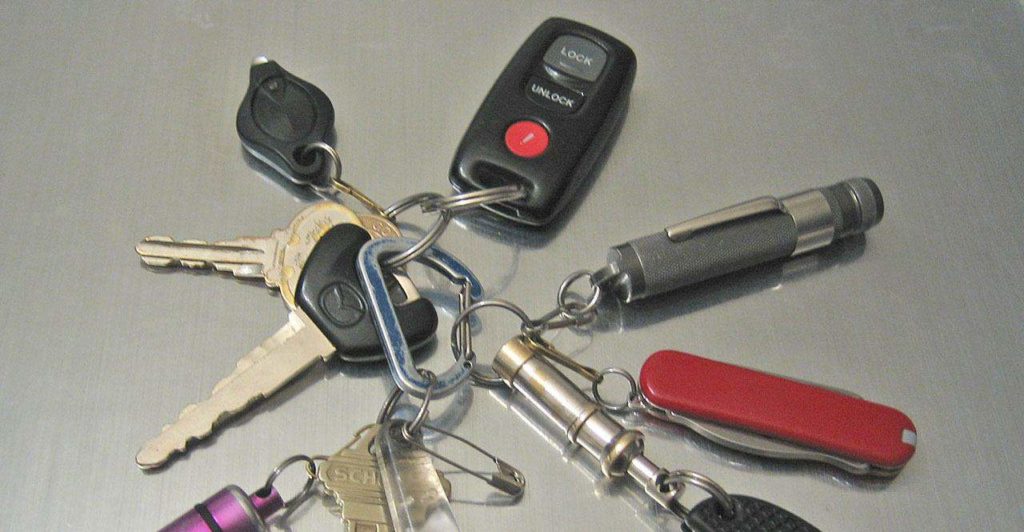Contents
When you put together a bugout bag or survival kit, you have to think about lighting once you have shelter, fire, first aid, and water covered.
The other categories matter all the time, but when the sun goes down or you’re in a dark building or tunnel, lighting seems like the only important thing.
This is where the survival flashlight comes into play. While you should have a headlamp and some glow sticks in your kit as well for hands-free use, the flashlight is often more powerful, easily shareable, and can be used tactically.
The brightness and rugged construction will allow you to use the light as a weapon, either to blind an opponent or with which to hit them.
Top 10 Survival Flashlights
1. Fenix E12 v2 – Best Affordable Survival Flashlight


When you want an inexpensive flashlight for close tasks, the Fenix E12 V2 should be high on your list. Of course, at only 160 lumens it isn’t going to be good for seeing hundreds of yards, but more than enough for up-close use.
The cost of these lights is low enough to have multiple around the house for power outages or as a backup in your bugout bag.
This flashlight is built much more durably than cheap plastic lights of the same light output. So when you need reliability but don’t need the brightness of larger flashlights, this is a good option.
The Fenix E12 V2 runs on a single AA battery, so it is easy to carry spares and you won’t have a problem finding them just about anywhere.
Pros
- Low price
- Lightweight
- Common battery size
Cons
- Short runtime
- Low brightness level
Specifications
- Max Brightness: 160 Lumens
- Run Time on High: 1 Hour
- Settings: High, Medium, Low
- Body Material: Aluminum
- Dimensions: 77 mm X 19 mm
- Weight: 27 grams
2. OLIGHT I3T EOS – Editor’s Choice EDC Survival Flashlight


The Olight I3T Eos comes as close to being a penlight as we cover in our list. Putting out a moderate 180 lumens on high is enough to light up a room, check an engine, or not trip over your feet when moving around in the dark.
The size is perfect for everyday use, carrying in your pocket, or keeping clipped to your car’s sun visor. In addition, Olight has given the I3T a unique texture with almost a screw thread around the body for a better grip.
The light has just a high and low setting, making operation simple. The low setting is enough to read a map or find gear in your backpack without being too visible.
This flashlight runs on a single AAA battery, which keeps the size down but does limit runtime. Since most headlamps use AAA batteries, you would only have to carry one type of spare for both types of lighting.
Pros
- Compact size
- Reliable
- Common battery size
Cons
- Limited modes
- Low brightness
- Short battery life
Specifications
- Max Brightness: 180 Lumens
- Run Time on High: 30-60 Minutes, depending on battery type
- Settings: High, Low
- Waterproof Rating: IPX 8
- Body Material: Aluminum
- Dimensions: 89 mm X 15 mm
- Weight: 39 grams
3. OLIGHT S1R II


The Olight S1R II is not much bigger than a tube of lipstick, but puts out an impressive 1000 lumens. The small size and lightweight nature make it easy to pack, even in your pocket. With the supplied clip, you can clip it to the bill of a baseball hat to go hands-free for tasks or while hiking.
The beam has a broad hot spot, making it best used for close-up tasks rather than a spotlight for distant searching.
With the small size does come a shorter battery life as it uses a smaller battery. It will only give you 1.5 minutes on full before dropping to 300 lumens for another 37 minutes.
If you use the medium or low modes, you will still get a long enough runtime for practical use.
However, the battery size doesn’t allow for the use of alkaline batteries, so make sure to bring the charging cable and USB charger to keep it topped up. It uses a magnetic USB charger which makes charging a breeze, especially in the dark.
Pros
- Compact size
- High level of brightness
- Magnetic charging cable
Cons
- Short battery life
- Automatically switches from
Specifications
- Max Brightness: 1000 Lumens
- Run Time on High: 1.5 minutes + 37 minutes at 300 lumens
- Settings: High, Medium, Low, firefly, Strobe
- Body Material: Hard Anodized 6061 Aluminum
- Dimensions: 63 mm X 21 mm
- Weight: 51 grams
4. SureFire G2X Pro


The SureFire G2X Pro is a moderately powerful flashlight at 600 lumens on its maximum setting. Made for simplicity, this flashlight only has a high and 15-lumen low mode.
The beam is a bright white with a smooth pattern, lighting up the distance and near more evenly than many other flashlights.
It uses a pair of CR123 batteries and doesn’t have the option of recharging unless you use rechargeable batteries with an external charger.
The build of this flashlight is rugged, with a mil-spec aluminum bezel, polymer body, and impact-resistant lens. The SureFire flashlights are made in the USA.
While simple, it lacks the brightness and features of some of the other flashlights at this price.
Pros
- Rugged construction
- USA made
Cons
- Uncommon battery size
- Not rechargeable
- Heavy
Specifications
- Max Brightness: 600 Lumens
- Run Time on High: 1.5 Hours
- Settings: High, Low
- Body Material: Hard Anodized 6061 Aluminum
- Dimensions: 135 mm X 30 mm
- Weight: 222 grams
5. Streamlight 88061 ProTac 1L-1AA


The Streamlight 88061 ProTac is a middle-of-the-road flashlight for both price and brightness. It puts out 350 lumens on high. It will run on both CR123 and AA batteries, increasing your refueling options.
The use of different battery types is a big plus, as everyone tends to have many AA batteries laying around to use if you are out of the CR123. This is important in a power outage situation, where you might be without light for a few days.
With an alloy body and impact-resistant glass, it will stand up to rugged use and bad weather. It is also a great size to use as a weapon if you are in a close-quarters self-defense situation.
The combination of brightness, lightweight, and dual-fuel battery usage make the Streamlight a good choice for home, vehicle, and bugout bag.
Pros
- Reliable
- Multiple battery options
- Simple to operate
Cons
- Moderate brightness, moderate run time
- Not the best value for the features
Specifications
- Max Brightness: 350 Lumens
- Run Time on High: 1.5 Hours
- Settings: High, Low, Strobe
- Body Material: Aluminum
- Dimensions: 108 mm X 25.4 mm
- Weight: 79 grams
6. ThruNite BSS V4 LED Flashlight
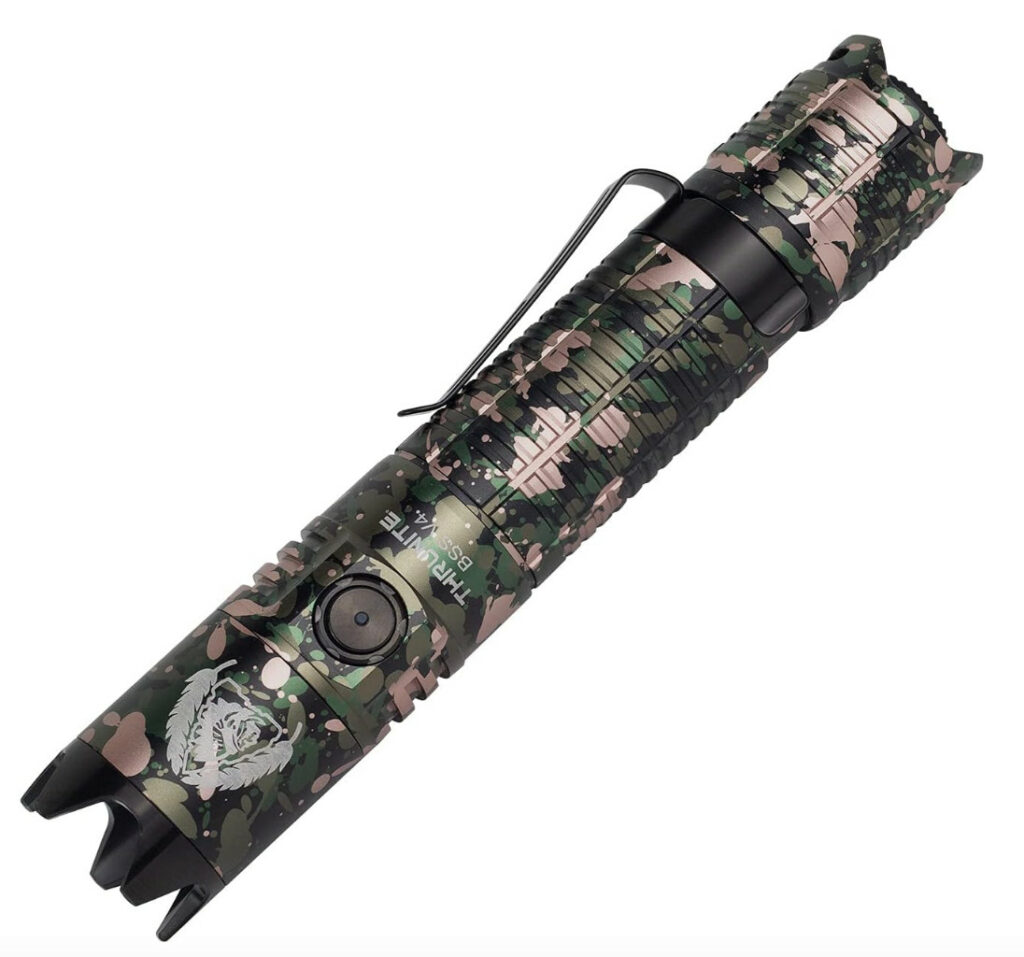

The ThruNite BSS V4 LED Flashlight is another flamethrower of a light from ThruNite. The Neutron is bright and stands up to challenging conditions.
The turbo mode puts out 1100 lumens, useful for both seeing far and self-defense, as it will blind any person or animal at night. The build quality is also tough enough to use as a self-defense baton.
The various brightness levels give you a flashlight with the versatility to search for distant landmarks and see up close to change a fuse.
The light is rechargeable, using the 18650 battery for maximum runtime but will also run on CR123 alkalines.
This flashlight is similar in spec to the TN12, but lacks the rear-mounted tap switch and is a few dollars cheaper.
All Thrunite lights come with a two-year warranty and they are very good with customer service.
Pros
- Bright
- Good value
- Multiple battery options
Cons
- Lacks rear tap switch for quick use
- Can face overheating during extended use on high
Specifications
- Max Brightness: 1100 Lumens
- Run Time on High: 2.2 Hours
- Settings: Turbo, High, Medium, Low, Firefly, Strobe
- Body Material: Hard Anodized 6061 Aluminum
- Dimensions: 125 mm X 25.4 mm
- Weight: 86 grams
7. Coast Polysteel 600


The Coast Polysteel 600 is slightly misnamed, as it puts out 710 lumens on high. However, the name redeems itself given the polymer case around a stainless steel core.
What is surprising is the quality of light from the reflector and the fact that it has a built-in focus ring that lets you go from flood to spot with a twist of the wrist.
The floodlight is broad and even. When you engage, the spotlight has a distinct hotspot but allows you to reach out much further, whether for navigation or identification.
The build quality and materials used allow a rugged and waterproof flashlight to stand up to all-weather outdoor use. However, it isn’t as well suited for use as a melee weapon as all-metal flashlights are.
The Polysteel 600 runs on 4 X AA batteries which can be bulky and heavy when carrying extras.
While there are great features with this light, it is the largest and heaviest of our tests, making it more suited for home or vehicle use, where you don’t have to carry it all the time. Using it in those situations will also make it easier to have spare batteries on hand to keep feeding it.
Pros
- Good value
- Well built
- Pretty bright for the price
Cons
- Heavy
- Battery hog
Specifications
- Max Brightness: 710 Lumens
- Run Time on High: 2.25 Hours
- Settings: High, Medium, Low
- Waterproof Rating: IPX 8
- Body Material: Polymer over a stainless steel core
- Dimensions: 200 mm X 50.8 mm
8. Coast PX1 565
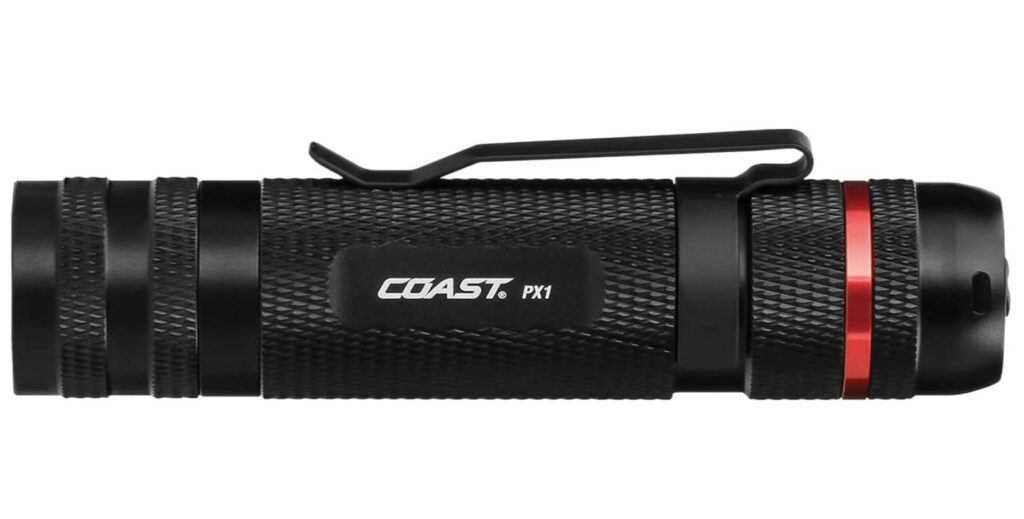

On the other end of the spectrum from the Polysteel 600, Coast offers the pocket-sized HP1. At 565 lumens, it’s a solid flashlight. Also, it is small enough to fit in the palm of your hand so you never have to be without it.
The PX1 is simple with only on/off, but it does have a sliding focus ring which allows you to switch from flood to spot. The flood gives even light for up-close work, while the spot lets you reach out further than other lights of the same brightness.
It runs on three AAA battery, but you can upgrade to Coast’s USB rechargeable lithium-ion battery. These are unique, as you plug the battery into a micro-USB cable rather than the light. This allows you to continue using the flashlight with a spare battery while the other is recharging.
The compact size and low price make this an excellent option for bugout bags and having in many rooms in your home in case of a power outage.
Pros
- Simple
- Reliable
- The rechargeable battery option is unique
Cons
- Only one setting
- Short runtime
Specifications
- Max Brightness: 565 Lumens
- Run Time on High: 3.5 Hours
- Settings: Single Setting
- Waterproof Rating: IPX8
- Body Material: Hard Anodized 6061 Aluminum
- Dimensions: 102 mm X 24 mm
- Weight: 71 grams
9. ThruNite TN12 – Editor’s Choice Best All Round Survival Flashlight


When you look to light up the night without breaking the bank, the ThruNite TN12 is an option worth checking out.
Its compact size and maximum output of 1000 lumens make for a potent package. It is rechargeable with a 18650 battery that you can easily replace. It will also run on a pair of CR123 batteries, so keep a couple of spares in your kit.
The beam pattern is pretty tight, so this is best used as a directional spotlight. It has a button on the side as well as a rear-mounted switch for tactical situations.
If you use the ThruNite TN12 on high for extended periods, the flashlight’s body can heat up quite a bit. This could potentially lead to overheating and shutting down until it has cooled. However, this heating isn’t an issue at any of the lower settings.
Pros
- Very bright
- Wide variety of modes
- Multiple battery options
Cons
- Narrow beam pattern
- Potential overheating issues when used on high
Specifications
- Max Brightness: 1100 Lumens
- Run Time on High: 2.2 Hours
- Settings: Turbo, High, Medium, Low, Firefly, Strobe
- Body Material: Hard Anodized 6061 Aluminum
- Waterproof Rating: IPX8
- Dimensions: 140 mm X 25.4 mm
- Weight: 87 grams
10. NITECORE MH12S – Editor’s Choice Premium Survival Flashlight


When you want a portable sun in your pocket, then look to the Nitecore MH12S. With 1800 lumens of output, it is enough to use as a weapon. Blast someone with this and all they will see are bright spots.
Pushing the lighting envelope, the Nitecore combines a category-leading light output with new battery technology for maximum runtime. The 21700 lithium-ion battery gives a better performance than the more common 18650.
In addition, the MH12S will run on a 18650 or a pair of CR123 batteries to add versatility, offering more choices when you can’t recharge it.
The circuitry has a built-in heat management system to maintain operation, even in adverse conditions. It also regulates the power for a much more even, steady light output.
There are both tactical and daily use modes. Tactical mode streamlines the lighting options to simplify getting the right setting under stress. You can also preset what mode you want to be in, as the memory will allow you to return to that setting.
The rear-mounted button allows for easy momentary flashes and activation when deployed with a handgun.
Nitecore has several weapons mounts that are compatible with this flashlight, as well as a remote switch.
Pros
- Brightest flashlight in our test
- Lightweight for the brightness
- Best rechargeable battery technology
Cons
- Various modes can be confusing
- Higher price point
Specifications
- Max Brightness: 1800 Lumens
- Run Time on Highest Setting: 45 Minutes
- Settings: Turbo, High, Medium, Low, Ultra Low, Strobe, Beacon
- Body Material: Hard Anodized 6061 Aluminum
- Waterproof Rating: IPX8
- Dimensions: 141 mm X 25.4 mm
- Weight: 78 grams
FAQ Section
How to Choose a Great Survival Flashlight
When choosing the best survival flashlight for your needs, you will have to look at several factors.
Unfortunately, many of those factors will offset each other. For instance, the brighter the flashlight, the less runtime or larger size and greater weight you will be forced to deal with.
Lumens
Lumens are a measure of brightness at 1 meter. While a higher lumen rating generally means the light will go further, this is also be affected by the design of the reflector and lens.
Most flashlights have multiple power settings, so you don’t have to run them on high all the time.
100 Lumens
These will usually be small penlights that can be carried in your pocket or on your belt. Useful for up-close work and maneuverability.
500 Lumens
A flashlight in this range will be bright enough to see about 100 yards. It can still be relatively small, but the smaller versions will sacrifice battery life.
Over 1000 Lumens
Flashlights this bright have a long-range and can be used to blind someone at night.
You can use any light to signal for rescue at night, but the brighter it is, the more likely you are to be seen. This brightness level can also be helpful when searching for landmarks or people due to the range.
The more powerful the light, the heavier it will be or the shorter the runtime it will have due to battery size.
Run Time
The longer the run time, the better. However, this will be a function of size and brightness, as we’ve stated above.
Considering how long you might need the light, you want to have at least 3 hours on high. For hiking and up close camp tasks, we suggest using your headlamp so you save the brightness of your flashlight for more demanding tasks.
Size and weight
If you are on foot, you want to minimize the size and weight of your flashlight. Unfortunately, when I have examined many people’s bugout bags, they have a combination of gear that adds up to be quite heavy.
Combining a heavy pack with the fact that most are a little older and not in peak fitness can increase the risk due to fatigue in a survival situation.
A larger model is appropriate in a vehicle since you don’t have to carry it all day. This scenario may also afford you the option of recharging your light, so a larger and brighter model might be feasible.
Build quality
A survival flashlight needs to be rugged and reliable enough to work when you need it. With any electronics, especially LED lighting with a circuit board, the build quality, materials, and design are paramount to have a flashlight work when you need it under adverse conditions.
The body and head of the flashlight should be made from aluminum rather than plastic if you want something that can be used as a self-defense tool.
Waterproof and Shock Resistant
The brightness and beam pattern mean nothing if it stops working if it gets dropped or wet.
Look for a flashlight that has an industry-standard rating for both shock resistance and waterproofing.
Batteries
Whether you choose a flashlight that is rechargeable or uses replaceable alkaline batteries is a tough call. Rechargeable lights are convenient, but you will have to have a method of keeping them charged.
Rechargeable flashlights can be practical with your vehicle kit, but with a multi-day bugout bag, you will have to allow for some method of recharging that will add weight.
A tiny USB brick battery has the advantage that it will charge multiple devices, including your phone, lights, and radios. The plus of rechargeable flashlights is you can keep them going indefinitely if you bring a compact solar panel.
Many rechargeable flashlights that use a 18650 battery can also be powered with 2 X CR123 alkaline batteries, but you will have to stock up as they aren’t easy to find at the local variety store.
Regular alkaline battery-powered flashlights are easy to find replacement batteries for in an urban environment. However, if you are in the wild, you will have to bring an adequate amount of backup batteries as you won’t have a way to keep your flashlight powered.
Accessories
A lot of survival flashlights have accessories that come with them or are available aftermarket. These include belt sheaths, colored lenses, pocket clips, o-rings, chargers, and even weapon mounts.
Depending on what use you plan to use your survival flashlight for will dictate what accessories make sense.
And remember, in a pinch, you can duct tape your flashlight to just about anything – which is one more reason to have the handyman special in your kit.
Budget
Depending on your financial situation and how likely you are to use it, the price of your flashlight will be a factor. For ‘just in case’ use, you can pick a lower-cost option as it is less likely to get used.
But if your job, hobbies, or locale puts you at more risk, then it is good to consider a higher quality flashlight, regardless of price.
2. How many lumens are enough for a survival flashlight?
How bright a flashlight you need will depend on the specifics of your survival scenario.
If you need to move at night, search for people or landmarks, or are in a tactical situation, then having a light of 1000 lumens or more is a good idea.
For vehicle breakdown, power outages, or wilderness use where you stay in place at night, then 100-300 lumens will get you by just fine.
3. What’s the best battery for a survival flashlight?
I like my flashlight to be rechargeable and be able to run on alkaline batteries in a pinch. This usually means a lithium-ion such as the 18650. The new batteries used by Nitecore offer even more for juice in a similar size package.
With rechargeable gear such as phones, GPS, and lights all using USB power, it is much easier to standardize your kit with items that all use the same power source to keep going. For example, you can top up with vehicle power, solar panels, or a portable battery bank.
Alkaline batteries in the AA or AAA size are convenient due to availability, but are wasteful and it’s heavy to carry many backups.
If you want to have as many devices as possible, use the same battery or charging system to minimize the amount of auxiliary gear you have to pack.
4. What are the ANSI FL1 standards for?
Whether it is sleeping bag temperature ratings or how bright a flashlight is, companies want their product to seem better than their competitors’. Enter the marketing department, where all sorts of unverifiable claims get made.
As has happened with sleeping bags, there is now an industry-standard test that means when you are comparing two flashlights, you are comparing apples to apples.
The ANSI FL1 standard will show you the lumens at each setting and how long the burn time is.
When it comes to run time at a given setting, the standard is set to the nearest 15 minutes. It also measures until the light output is down to 10%. So when you see that it has 60 minutes on high, don’t expect you will have full brightness the whole time.
5. How does IPX code rating work?
The IPX rating is for dust and waterproofing.
If two numbers are listed, the first is for dust and the second is for water.
IPX 4 – Protection from splashing water from any direction
IPX 5 – Spraying water from any direction
IPX 6 – High-pressure spray from any direction
IPX 7 – Submersion of 1 meter for 30 minutes
IPX 8 – Submersion of more than 1 meter. The manufacture will label with the depth up to and time for which the item will remain waterproof.
6. How to use a flashlight safely?
Never look directly into the light. Modern LED lights have the power to damage your eyes permanently.
It’s best to be especially careful at night, as you will have adapted to lower light conditions, which means the pupil is wide open.
If you use rechargeable flashlights, you should charge them every three months even if you aren’t using them, as they lose power over time.
When changing batteries, make sure that water doesn’t get in the compartment. If this happens, make sure to open it up and dry it out when you have the chance in order to avoid issues with corrosion.
Our Choice
There are as many flashlights as there are survival scenarios. However, the needs indoors during a power outage are different from those when lost in the woods. If you are also using the flashlight for part of your personal defense system, maximum brightness and a rear-mounted switch are essential.
Our list will give you a good selection of high-quality flashlights that will fill your requirements and keep you seeing in the dark.
Whether you need the retina-burning brightness of the Thrunight BSS or the pocket size of the Olight I3T Eos will depend on the situations you’ve prepared for and expect to encounter.


